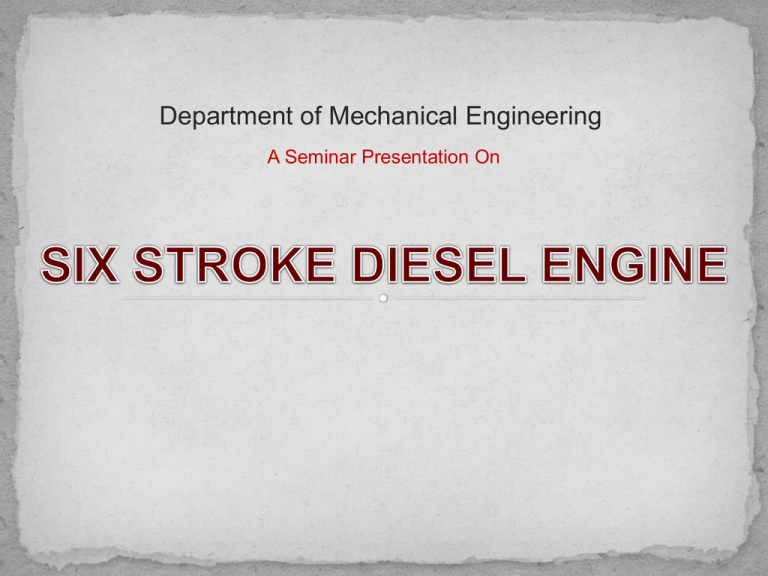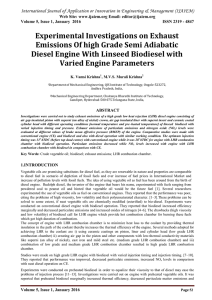
Department of Mechanical Engineering
A Seminar Presentation On
Introduction
Types of Six stroke engines
Bajulaz Six stroke Diesel engine
Dual fuel Six stroke engine
Comparison
Specifications
Features
Performance and economy
Conclusion
The six-stroke engine is a type of internal
combustion engine based on the four-stroke
engine.
First developed in early 1990’s
Advancement is the Duel fuel six stroke
diesel engine
More efficient & reduce emissions.
Approaches for six stroke engine design
First approach
There is two additional strokes by the
main piston as fifth and sixth stroke
Second approach
It uses a second opposed piston which
moves at half the cyclical rate of the main
piston
Griffin six
stroke engine
FIRST
APPROACH
Bajulaz six
stroke engine
Crower six
stroke engine
SIX STROKE
ENGINE
Velozeta six
stroke engine
SECOND
APPROACH
Beare head
six stroke
engine
Charge pump
engine
1. Intake valve
2. Heating chamber valve
3. Combustion chamber valve
4. Exhaust valve
5. Cylinder
6. Combustion chamber
7. Air heating chamber
8. Wall of combustion chamber
9. Fuel injector
10.Heater plug
Intake of pure air in the
cylinder
STROKE 1
STROKE 2
STROKE 3
Compression of pure air in
heating chamber
Release of combustion
gases in the cylinder
STROKE 4
Recompression of pure air
in the combustion chamber
STROKE 5
Release of pure air
into cylinder
STROKE 6
Exhaust of combustion gases
This engine runs by two fuels i.e. diesel (primary fuel) and
methanol (secondary fuel)
Table 1. Specifications of the test engine:
Engine type
Four stoke
Six stroke
Diesel Engine
Diesel Engine
DI, Single cylinder, Air cooled, OHV
Bore x Stroke [mm]
82 x 78
Displacement [cc]
412
Top Clearance [mm]
0.9
Cavity Volume [cc]
16
Compression ratio
21
Intake Valve Open
100 BTDC
70 BTDC
Intake valve Close
1400 BTDC
1450 BTDC
Exhaust Valve Open
1350 ATDC
1400 ATDC
Exhaust Valve Close
120 ATDC
30 ATDC
Valve Overlap
Rated power
220
100
5.9 kW /3000rpm
Base Engine
----------------
Comparison between four stroke & six stroke diesel engines
Engine Parameters
Four Stroke
Diesel Engine
Six Stroke
Diesel Engine
Engine Speed Ne [rpm]
2007
2016
Supplied combustion heat per cycle
Qt [KJ/cycle]
Supplied combustion heat per unit time Ht [KJ/s]
0.50
0.68
8.36
7.62
358.7
371.4
11.8
16
2.40
1.83
6.00
4.16
0.197
15.52
3.26
217.9
5.94
19.10
4.01
177.2
0.179
15.28
3.24
520.3
4.37
18.71
3.75
163.3
Intake air flow per cycle
Ma [mg/cycle]
Injection quantity per cycle
Mf [mg/cycle]
Excess air ratio λ
Intake air flow per unit time
Ma [g/cycle]
Injection quantity per unit time
Mf [g/sec]
Brake torque Tb [N-m]
Brake power Lb [KW]
BSFC. b [ g / KW-h]
IMEP Pi [Kgf / cm2]
Indicated torque Ti [N-m]
Indicated power Li [KW]
ISFC bi [g / KW-h ]
Comparison between six stroke diesel & dual fuel six stroke engines
Engine Speed Ne [rpm]
Diesel Fuel Six Stroke
Dual Fuel Six Stroke
Diesel Engine
Diesel Engine
2016
2006
Supplied combustion heat per cycle
Qt [kJ/cycle]
0.68
Injection quantity per cycle
8.0
(First Combustion Stroke)
(Diesel Fuel)
Mf1 [mg/cycle]
Injection quantity per cycle
8.0
17.2
(Second Combustion Stroke)
(Diesel Fuel)
(Methanol)
Excess air ratio λ
1.86
1.93
Brake torque Tb [N-m]
6.18
6.08
Brake power Lb [kW]
1.52
1.5
B.S.F.C.
504.0
777.7
I.M.E.P. Pi [kgf / cm2]
4.56
4.75
Indicated torque Ti [N-m]
21.68
20.38
Indicated power Li [kW]
3.45
2.98
I.S.F.C. bi [g / kW.h ]
155.5
236.2
6.61
6.37
Mf2 [mg/cycle]
b [ g / kW.h]
Indicated specific heat consumption
bi’ [MJ /kW.h]
Lower maintenance costs
due to less wearing parts
(cylinder head)
Longer service intervals
possible due to lower
operating temperatures
recorded
Increase in thermal
efficiency by more than 20%
Reduced fuel consumption
Four Stroke
Six Stroke Diesel
Dual Fuel Six
Diesel Engine
Engine
Stroke Engine
113
90.5
(85.3%)
(88.2%)
28.8
0
6.8
(- 323.5%)
(100%)
7.51
6.61
6.37
(12.0%)
(15.2%)
Nitrous Oxide [ppm]
( % improvement)
768
Soot [%]
(%improvement)
Indicated specific heat consumption
bi’ [MJ/KW-h]
(% improvement)
Reduction in fuel consumption by at least 40%
Two expansions(work/Power stroke) in six strokes
Dramatic reduction in pollution ( up to 65%)
Higher overall efficiency
Lower engine temperature & noise level
Due to more air intake, the cooling system is improved
Better scavenging and more extraction of work per cycle
Less inertia due to lightness of moving parts
Brake power & indicated power per cycle per
cylinder is comparatively lesser
Engine size increases due to many number of
cylinders & additional components
Higher manufacturing cost of six stroke engine
Automobiles, heavy goods, construction-site and
farm vehicles.
motor-pumps, generator sets, stationary engines,
etc....intended for agriculture and industry.
Motorboats
Drastically reducing fuel consumption (by 40%) and
pollution (by 60-90%) without radically affecting
performances
For the dual fuel six-stroke engine, soot & nitrous oxide was
practically eliminated by a small amount of methanol in the
second combustion process.
It enables lower engine temperature and therefore increases
in the overall efficiency.



